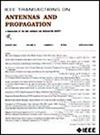Study on Extremely Compact Triple Band-Rejected Antenna in Indoor Propagation Channel for IR UWB and Biomedical Applications
IF 4.6
1区 计算机科学
Q1 ENGINEERING, ELECTRICAL & ELECTRONIC
引用次数: 0
Abstract
This communication investigates the frequency- and time-domain features of an extremely compact super-wideband slot antenna designed for impulse radio (IR) ultrawideband (UWB) and biomedical applications. The antenna employs a circular radiation patch and a rectangular slot in the ground plane, with optimized dimensions to achieve super-wide bandwidth. To address interference issues with co-existing narrowband systems, two inverse L-shaped stubs are connected to the ground plane, effectively rejecting the WiMAX spectrum. In addition, two circle-like ring slots are embedded into the radiation patch to create band-rejected features for WLAN and X-band downlink frequencies. Despite its compact size of用于红外超宽带和生物医学应用的室内传播信道极紧凑三带抑制天线的研究
本文研究了一种为脉冲无线电(IR)超宽带(UWB)和生物医学应用而设计的极其紧凑的超宽带缝隙天线的频域和时域特征。天线采用圆形辐射贴片和接地面矩形缝隙,优化尺寸,实现超宽带宽。为了解决共存窄带系统的干扰问题,两个反l型存根连接到地平面,有效地抑制WiMAX频谱。此外,两个圆形环形槽嵌入到辐射贴片中,为WLAN和x波段下行频率创建带抑制特性。尽管其体积小巧,仅为$14\ × 14$ mm ($0.13\lambda _{\text {g}} \ × 0.13\lambda _{\text {g}}$),但该天线的带宽从2.8 GHz扩展到20 GHz以上,适用于UWB (3.1-10.6 GHz)和ku波段(12-18 GHz)应用。本文还探讨了天线对红外生物医学应用中发射和接收超窄脉冲的影响,并使用系统保真度因子(SFF)进行了评估。这项工作的一个值得注意的贡献是研究了在典型的室内传播信道中所提出的天线的时域特性。仿真和实测结果表明,该天线具有良好的频域和时域特性。
本文章由计算机程序翻译,如有差异,请以英文原文为准。
求助全文
约1分钟内获得全文
求助全文
来源期刊
CiteScore
10.40
自引率
28.10%
发文量
968
审稿时长
4.7 months
期刊介绍:
IEEE Transactions on Antennas and Propagation includes theoretical and experimental advances in antennas, including design and development, and in the propagation of electromagnetic waves, including scattering, diffraction, and interaction with continuous media; and applications pertaining to antennas and propagation, such as remote sensing, applied optics, and millimeter and submillimeter wave techniques

 求助内容:
求助内容: 应助结果提醒方式:
应助结果提醒方式:


